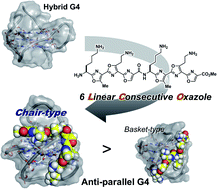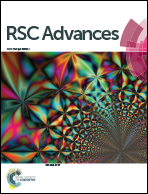Linear consecutive hexaoxazoles as G4 ligands inducing chair-type anti-parallel topology of a telomeric G-quadruplex†
Abstract
G-quadruplex structures (G4s) in guanine-rich regions of DNA play critical roles in various biological phenomena, including replication, translation, and gene expression. There are three types of G4 topology, i.e., parallel, anti-parallel, and hybrid, and ligands that selectively interact with or stabilize a specific topology have been extensively explored to enable studies of topology-related functions. Here, we describe the synthesis of a new series of G4 ligands based on 6LCOs (6-linear consecutive oxazoles), i.e., L2H2-2M2EA-6LCO (2), L2A2-2M2EAc-6LCO (3), and L2G2-2M2EG-6LCO (4), which bear four aminoalkyl, acetamidealkyl, and guanidinylalkyl side chains, respectively. Among them, ligand 2 stabilized telomeric G4 and induced anti-parallel topology independently of the presence of cations. The anti-parallel topology induced by 2 was identified as chair-type by means of 19F NMR spectroscopy and fluorescence experiments with 2-aminopurine-labeled DNA.



 Please wait while we load your content...
Please wait while we load your content...